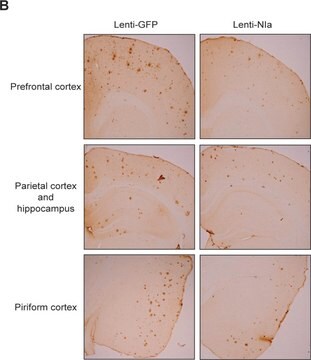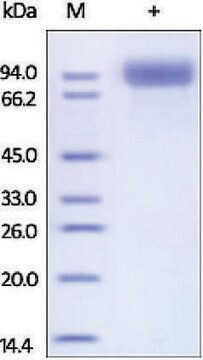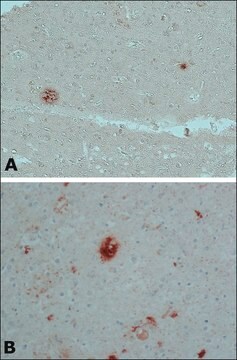추천 제품
생물학적 소스
rabbit
Quality Level
결합
unconjugated
항체 형태
IgG fraction of antiserum
항체 생산 유형
primary antibodies
클론
polyclonal
양식
buffered aqueous solution
분자량
antigen 95-100 kDa
종 반응성
human, rat, mouse
기술
immunohistochemistry (formalin-fixed, paraffin-embedded sections): 1:200 using formic acid-treated sections of human Alzheimer′s disease (AD) brain
microarray: suitable
western blot: 1:1,000 using rat brain extract or supernatant of 293T cells secreting APP.
UniProt 수납 번호
배송 상태
dry ice
저장 온도
−20°C
타겟 번역 후 변형
unmodified
유전자 정보
human ... APP(351)
mouse ... App(11820)
rat ... App(54226)
일반 설명
Amyloid precursor proteins (APPs) are transmembrane glycoproteins that are found in a wide range of tissues. APPs have 3 main isoforms, namely, APP695, APP751 and APP770 that are derived from alternative splicing events in cells. It is expressed at high levels in the brain. APP gene is mapped to human chromosome 21q11.2-q21. It is a 695 amino acid protein which possesses a large ectodomain and comparatively short intracellular region.
The immunogen sequence is identical to the APP isoforms APP751 and APP770 and is highly conserved (single amino acid substitution) in rat and mouse APP695. The antibody recognizes APP695, APP751 and APP770.
면역원
synthetic peptide corresponding to the N-terminal of human APP695 (amino acids 46-60) conjugated to KLH.
애플리케이션
Anti-Amyloid Precursor Protein, N-Terminal antibody produced in rabbit has been used in:
- western blotting
- immunostaining
- immunofluorescence
Applications in which this antibody has been used successfully, and the associated peer-reviewed papers, are given below.
Immunofluorescence (1 paper)
Immunofluorescence (1 paper)
SH-SY5Y cell lysates were analyzed by western blot using rabbit anti-Amyloid Precursor Protein, C-Terminal as the primary antibody at a 1:500 dilution.
생화학적/생리학적 작용
Amyloid precursor proteins (APPs) regulates cell growth, motility, neurite outgrowth and cell survival. The intracellular C-terminus of APP serves as a transcriptional regulator and as a receptor for kinesin-1-mediated axonal transport. Alzheimer′s disease is characterized by deposition of amyloid in the central nervous system, in neurite plaques and on cerebral vasculature. Mutations in the APP gene are linked with rare forms of autosomal dominant familial Alzheimer′s Disease (FAD). APPs undergo post-translational processing including N- and O-glycosylation, phosphorylation and sulfation.
물리적 형태
Solution in 0.01 M phosphate buffered saline, pH 7.4, containing 15 mM sodium azide.
면책조항
Unless otherwise stated in our catalog or other company documentation accompanying the product(s), our products are intended for research use only and are not to be used for any other purpose, which includes but is not limited to, unauthorized commercial uses, in vitro diagnostic uses, ex vivo or in vivo therapeutic uses or any type of consumption or application to humans or animals.
적합한 제품을 찾을 수 없으신가요?
당사의 제품 선택기 도구.을(를) 시도해 보세요.
Storage Class Code
10 - Combustible liquids
WGK
nwg
Flash Point (°F)
Not applicable
Flash Point (°C)
Not applicable
Association of TrkA and APP Is Promoted by NGF and Reduced by Cell Death-Promoting Agents
Canu N, et al.
Frontiers in Molecular Neuroscience, 10 (2017)
Neuropathological Alterations in Alzheimer Disease
Serrano-Pozo A, et al.
Cold Spring Harbor Perspectives in Medicine, 1(1) (2011)
The Alzheimer amyloid precursor protein maps to human chromosome 21 bands q21. 105-q21. 05
Korenberg JR, et al.
Genomics, 5(1), 124-127 (1989)
Migration of blood cells to beta-amyloid plaques in Alzheimer's disease
Hohsfield LA, et al.
Experimental Gerontology, 65, 8-15 (2015)
Dopamine induces apoptosis in APPswe-expressing Neuro2A cells following Pepstatin-sensitive proteolysis of APP in acid compartments
Cagnin M, et al.
Brain Research, 1471, 102-117 (2012)
자사의 과학자팀은 생명 과학, 재료 과학, 화학 합성, 크로마토그래피, 분석 및 기타 많은 영역을 포함한 모든 과학 분야에 경험이 있습니다..
고객지원팀으로 연락바랍니다.







